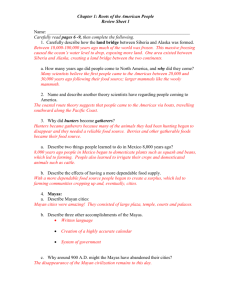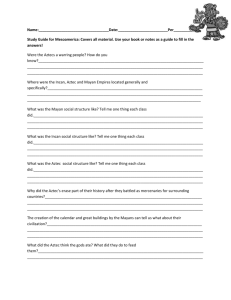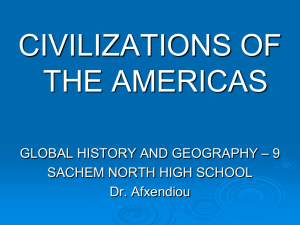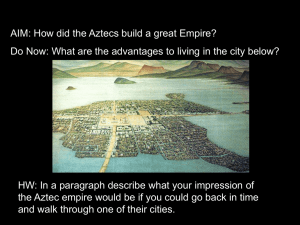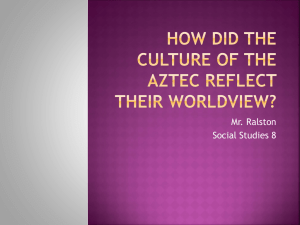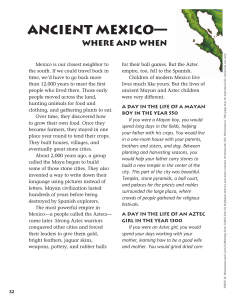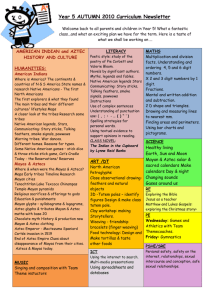THE LAND OF THE AMERICAS
advertisement
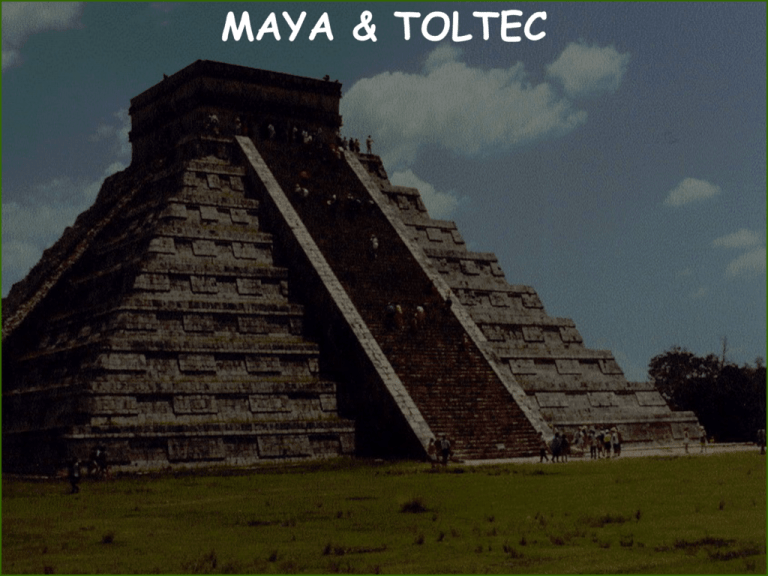
MAYA & TOLTEC • On the Yucatan Peninsula east of Teotihuacán, the highly YUCATAN sophisticated Mayan civilization flourished between 300 to 900 CE. MAYAN CALENDAR • The Mayan civilization covered much of Central America and southern Mexico. • The Maya built splendid temples and pyramids, and developed a complicated calendar. TIKAL • Mayan cities were built around a central pyramid topped with a temple to the gods. • Nearby were temples, palaces, and a sacred ball court. • Urban centers such as Tikal may have had a 100,000 inhabitants. MAYAN CIVILIZATION • Mayan civilization was composed of city-states governed by a hereditary ruling class. • The states warred on each other. • Captured nobles and war leaders were used for human sacrifice. • Other war captives were enslaved. MAYAN SOCIETY • Mayan rulers claimed to be descended from the gods. • Mayan society also had townspeople who were artisans, officials, and merchants. • Most Mayans were farmers, however. • Labor divided along traditional gender lines. A detail from a sacred Maya mural at San Bartolo — the earliest known Maya painting, depicting the birth of the cosmos and the divine right of a king ITZAMNA • The belief that all life is in the hands of divine powers was crucial to Mayan civilization. • Itzamna was the supreme god, and some gods, like the jaguar god of the night were evil. HUMAN SACRIFICE • Like other ancient peoples in Central America, one way the Maya appeased the gods was through human sacrifice. • Human sacrifice was also performed on certain ceremonial occasions. MAYAN BALL COURTS • The walls of the ball courts were covered with images of war and sacrifice. • The exact rules of the game that was played are unknown, but we do know that small teams tried to send a ball through a hoop using their hips. DEADLY GAME • The game had religious meaning because the court symbolized the world, and the ball represented the sun and the moon. • The defeated team was sacrificed. MAYAN BALL COURT HIEROGLYPHS • The Mayans created a writing system using hieroglyphs, or pictures. • Unfortunately, the Spaniards assumed the writings were evil because they were not Christian, and they destroyed many Mayan books, a pattern the Spanish would repeat throughout their conquest in the Americas. MAYAN STELLE THE LONG COUNT • The long count was based on the belief in cycles of creation and destruction. • The Maya believed our present world was created in 3114 BCE and would end on December 23, 2012 CE. • Many other hieroglyphs recorded important events in Mayan history, especially events in the lives of Mayan rulers. MAYA 260 DAY CALENDAR MAYA CALENDAR • Priests used a sacred calendar of 260 days to foretell the future and know the omens associated with each day. • Only priests could read and use the calendar. MAYA SUNSTONE CALENDAR THE TOLTEC TOLTEC STAR PRINCESS TOLTEC WARRIORS • The Toltec were a fierce and warlike people who conquered the Mayan lands of Guatemala and northern Yucatan. CHICHEN ITZA • The Toltec's built great palaces a pyramids, controlling the upper Yucatan Peninsula from Chichen Itza. • They came to power around 900 CE and declined around 1200 CE. THE AZTECS AZTEC HISTORY • Sometime during the 12th century CE, the Aztec began a long migration to the Valley of Mexico. • They established their capital at Tenochtitlan on an island in the middle of Take Texcoco, where Mexico City is today. Tenochtitlan HUITZILOPOCHTLI • According to legend, the Aztec believed that a sign would come from the god of war and of the sun, Huitzilopochtli, telling them where to settle. GOD OF SUN GOD OF WAR LAKE TEXCOCO • In 1325 they were driven into the swamps and islands of Lake Texcoco, where they saw an eagle standing on a cactus growing out of a rock, the sign that had been foretold. TENOCHTITLAN • They built a magnificent city of temples, other public buildings, and roadways linking the islands and mainland. TENOCHTITLAN AT TIME OF CONQUEST AZTEC EMPIRE BUILDING • The Aztec Kingdom was a collection of semi-independent territories governed by lords. • The Aztec ruler supported the lords in return for tribute—goods or money paid by conquered people to their conqueror. AZTEC WAR LORDS PAYING TRIBUTE TO THE KING VALLEY OF MEXICO • By 1500 up to 4 million Aztecs lived in the Valley of Mexico and its environs. • Power was in the hands of the god-king, who claimed descent from the gods. ANCIENT AZTEC RUINS—VALLEY OF MEXICO AZTEC SOCIETY • The Aztec population consisted of commoners, indentured servants, and slaves, who were war captives and worked in the houses of the wealthy. • Most people were commoners and farmers. • Merchants also lived in cities. GENDER DIVISION • Women were not equal to men, but could inherit property and enter into contracts, something not often allowed in other world cultures of the time. • They were also allowed to be priestesses. QUETZACOATL • Quetzalcoatl was the feathered serpent god. • According to Aztec tradition, he left his homeland and vowed to return in triumph. • This became part of a legend about a prince whose return from exile would be preceded by a sign of an arrow through a sapling. SPANISH CONQUISTADORS • When the Aztec saw the Spanish with a cross n their breastplates, they mistook the Spanish for Quetzalcoatl's representatives because the cross looked like the sign they had been waiting for. AZTEC RELIGION • Aztec religion was based on the belief in an unending struggle between the forces of good and evil, which led to the creation and destruction of a series of worlds. HUMAN SACRIFICE • Aztec religion practiced human sacrifice to postpone the day of destruction of their world, the 5th world. • A massive pyramid at the center of the capital was topped with shrines to the gods and an altar for human sacrifice. UNREST IN TENOCHTITLAN • The lords in the eastern provinces wanted greater independence from the Aztec king. • Areas that had not been conquered wanted to remain free. HERNAN CORTES • In 1519 a Spanish force under the command of Hernan Cortes marched to Tenochtitlan. • He had only 550 soldiers and 16 horses, but he made allies with the city-states that had tired of Aztec rule. MONTEZUMA • Cortes was greeted warmly by the Aztec king, Montezuma, who believed his visitor represented Quetzalcoatl. • Montezuma offered gifts of gold and a palace to use. AZTEC REVOLT • Tensions arose between the Aztec and Spanish. • In 1520 the local population revolted and drove the Spaniards from the city, killing many. AZTEC RECORDED STORY OF SPANISH CONQUEST DISEASE • Many Aztec also soon died from European diseases, such as smallpox and diphtheria. • They had no immunity to European bacteria and viruses. AZTEC RECORDED HISTORY OF SMALLPOX DISEASE SPANISH CONQUEST • Cortes received troops from his local allies, and in 4 months the city surrendered to his forces. • The use of gunpowder also aided the Spanish considerably in their battles with the Aztec. • They leveled the Aztec buildings and used the stones to construct government buildings and churches.
